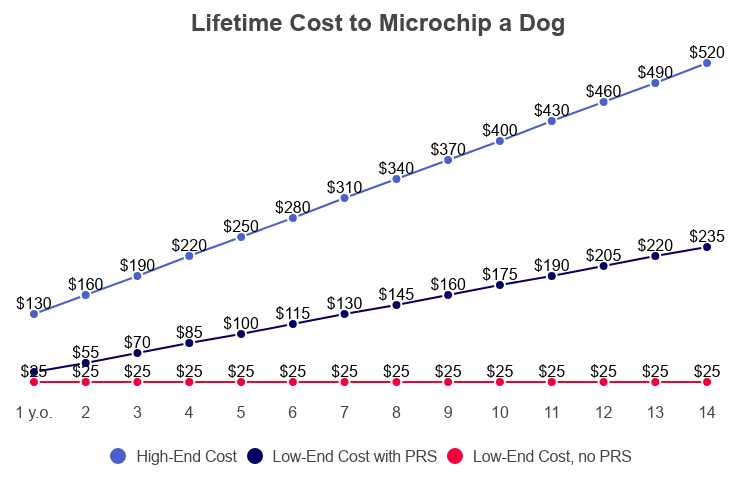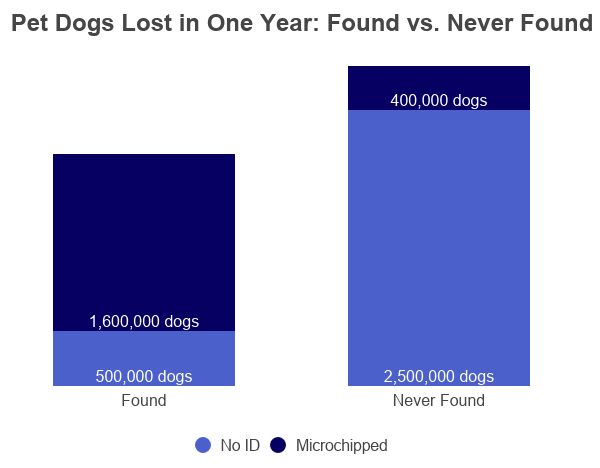Report Highlights. The cost to microchip a pet is less than most magazine subscriptions. Microchips have helped recover over 3 million lost pets, and statistics indicate that any ID significantly increases a pet’s chances of making it home.
- $45 is the average one-time cost to microchip a pet.
- For less than $500 over the course of your pet’s lifetime, you can keep them registered with a top national pet recovery service (PRS).
- It is possible to get your pet microchipped absolutely free depending on what services are available in your area.
- It’s common practice for animal shelters to microchip pets, often at no charge, before adopting them out.
| Item | Low-End Cost | High-End Cost |
|---|---|---|
| Microchip | Free | $30* |
| Implantation | $25** | $50 |
| Registration | Free | $20 |
| Pet Recovery Service | $15 | $400+ |
*Typically includes a whole kit.
**Some shelters offer discount or free microchipping under certain circumstances.
Pet Microchipping Costs
It’s very easy and inexpensive to buy a microchip for a companion animal. Most veterinarians have them available. There are also microchip implantation kits available for retail purchase, but those are intended for use only by a licensed veterinarian. In order for an implanted microchip to work, its registration must also contain identifying information about the animal as well as how to contact the owner.
- $45 is a typical fee for veterinarians to implant a microchip.
- Animal shelters sell registered microchips for as little as $5.
- Animal shelters also typically implant a microchip before putting a pet up for adoption.
- Microchip implant kits are generally $10-$30 online; the kits are to be administered by a veterinarian only.
- Databases such as the American Kennel Club (AKC) Reunite program allow you to register the microchip’s unique identification number for free.
- Pet recovery services keep their own databases, which are usually available for an annual subscription or a one-time fee.
- No surgery, anesthesia, or recovery time is required, making microchipping implantation less expensive than other common veterinary procedures, such as neutering.
- Some communities, such as the City of San Antonio, offer free microchips to pet owners.
- Since microchips are designed to last for 25 years, most pets only ever need one.
- Some microchip kits come with free engravable tags that include the microchip’s ID number.

Pet Recovery Service Costs
The cost of a microchip usually includes registration with the manufacturer’s database. Additional fees are required to register the chip’s unique identification number with a pet recovery service (PRS). These services are usually offered with a one-time registration fee or a nominal annual subscription.
- Less than $2.00 per month is the cost of a subscription with most pet recovery services.
- HomeAgain charges a $17.99 annual fee; that’s less than $1.50 per month before taxes.
- Many companies charge a one-time registration fee.
- Pet recovery services don’t usually cover the cost of travel expenses to help an animal get home.
- A single national PRS has the resources to help 10,000 lost pets return home every month using microchip registries.
What Is a Microchip?
Microchips are not tracking devices; they simply store a pet’s unique identification numbers, which may then be cataloged in a database along with any contact information the owner provides. Here’s how it works:
- Register. Every microchip comes with a unique identification number. A microchip can then be registered with a national pet recovery service and/or microchip database along with the owner’s contact and any other pertinent information, such as medical needs.
- Implant. A microchip is so small that a veterinarian injects it with a syringe. The microchip is always injected between an animal’s shoulder blades. A standardized injection location makes it easy to find, so anyone with a scanner can tell right away if an animal is microchipped.
- Scan. Scanning animals for microchips is now standard procedure in animal shelters and rescues. The scanner emits just enough energy to activate the microchip, which responds with its unique ID number. The number appears on the scanner readout or on a computer with special software installed.
- Input. There is no one centralized microchip registry, but ID numbers have characteristics unique to their manufacturer (similar to how credit card numbers have digits linking them to their credit provider). The American Animal Hospital Association (AAHA) maintains a search engine that locates the microchip registry or manufacturer associated with a pet’s ID.
- Ping. When an animal is reported missing to a PRS, the service monitors microchip registries for any activity related to the animal’s ID number. If someone enters that particular number into a registry search engine, a series of pings submits the entry to the registry itself, which then goes to the recovery service, and finally to the owner.
- Alert. After a PRS records a ping from the microchip, the owner is notified. Some services proactively release lost pet alerts to shelters, veterinarians, and pet rescue volunteers.
- Recover. A PRS will also help runite you with your pet. They may even help pay for a companion animal’s travel expenses if the distance is exceptional.
| Veterinarians and shelters recommend a traditional collar tag ID in addition to a microchip. |
|---|
| Collar tags are highly visible, whereas microchips are not. A collar with tags lets passersby know this lost dog is someone’s pet and not a stray. |
| Not all animal control and rescue services have universal microchip scanners. If a pet’s ID number is on a readable tag, the number can be manually entered into a registry search engine. |
| Phone numbers on pet collars make reconnection faster and easier. Anyone with a phone can contact the owner right away without using animal shelter resources. |
| Pets with health conditions should have medical alert tags so veterinarians know how to treat them right away without having to access the information via microchip. |
Pet Microchipping Statistics
For over 20 years, microchipping has been the only method of animal identification that is permanent; a microchip can’t get lost or fall off. Microchips are also capable of storing a lot more information than a traditional dog tag. Some communities actually require that animals be microchipped so animal control officers and shelters have instant access to their records.
- Over 3 million pets have been recovered using microchip registration.
- 38% of dogs and cats are microchipped.
- 22% of cats are microchipped.
- 41% of dogs have a microchip implanted.
- That’s 36.8 million of the total 89.7 million pet dogs in the United States.
- As many as 77% of found lost dogs are microchipped.
- 74-83% of lost microchipped dogs return home compared to 13-19% of dogs lacking identification.

Lost Pet Statistics
It’s common for pets to get lost, and many are found again. A quick walk around the neighborhood is usually all it takes to locate an animal. Some pets, however, are taken to animal shelters. A microchip, as long as its registration is kept up to date, helps the shelter know how to get the animal home again.
- 1-in-3 family pets will go missing in their lifetime.
- 59% of lost cats return home on their own.
- 56% of lost cats have no form of identification.
- 11% of lost dogs have no form of identification.
- 86% of permanently lost dogs have no identification.
- 14% of dog owners lose their pet within a five-year period.
- 46% of lost dogs get lost repeatedly.
- 28% of lost dogs are found by calling or visiting animal shelters.
- 15-20% of shelter dogs are reunited with an owner.
- 22% of shelter dogs are euthanized, often due to lack of space or funding.
- 35 states have laws about how long a shelter must hold an animal prior to authorizing euthanasia.
- In states with holding laws, the minimums range from 48 hours to 10 days.
- An estimated 10 million pets are lost in the United States every year; cats and dogs enter shelters in (nearly) equal amounts.
- Americans spend over $2 billion annually on animal control, shelters, and euthanasia/disposal.
Sources
- HomeAgain Fact Sheet
- American Veterinary Medicine Association (AVMA) Pet Ownership and Demographics Sourcebook
- Lost Pet Statistics
- The City of San Antonio Animal Care Services Microchipping
- American Kennel Club (AKC) Reunite, Single Indigo ISO+ Microchip with Tag
- University of Florida College of Veterinary Medicine, Rethink the Microchip and Boost Your Return-to-Owner Rate
- American Animal Hospital Association (AAHA), Universal Pet Microchip Lookup
- American Humane Association (AHA), “Every Day is Tag Day” – Is Your Pet Protected?
- The Humane Society of the United States (HSUS), High Tech: Identifying Lost Pets with Microchips
- Free Pet Chip Registry
